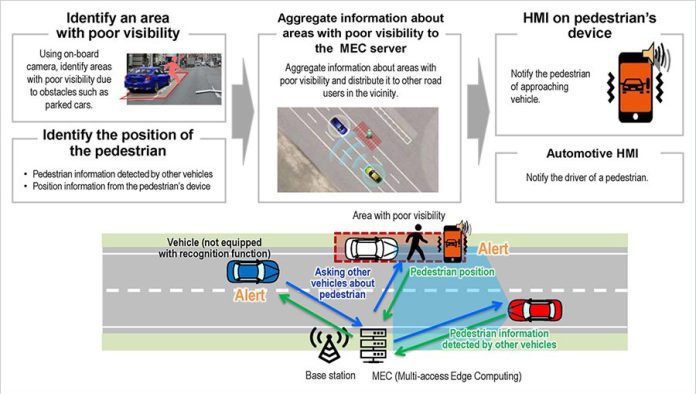Japanese operator SoftBank and compatriot car maker Honda announced they have started a use case-based verification of technologies to reduce collisions between pedestrians and vehicles using a 5G Standalone mobile communication system and a cellular V2X communication system.
Using SoftBank’s 5G SA experimental base station installed at Honda’s Takasu Proving Ground, located in Takasu Town, Hokkaido Prefecture, and Honda’s recognition technology, SoftBank and Honda are conducting technology verifications for the following three use cases:
-Reduce collisions involving pedestrians who are visible to vehicles: In an environment where a pedestrian can be seen from the moving vehicle, and when the vehicle’s on-board camera recognizes the risk of a collision such as the pedestrian entering the roadway, the vehicle sends an alert to the pedestrian’s mobile device directly or via an MEC server. The partners noted that this use case will enable the pedestrian to take evasive action to prevent a possible collision with the vehicle.
-Reduce collisions involving pedestrians who are not visible to vehicles: In an environment where a pedestrian cannot be seen from the moving vehicle due to obstacles such as parked cars along roadsides, the vehicle checks with mobile devices and other vehicles nearby about the presence or absence of a pedestrian in an area with poor visibility. If there is a pedestrian present, the system notifies the pedestrian of the approaching vehicle and also notifies the vehicle of the pedestrian from the pedestrian’s mobile device. When there is a second vehicle in a position to see the pedestrian that is in the area with poor visibility, that vehicle notifies the other vehicle of the pedestrian.
-Reduce collisions involving pedestrians by sharing information about areas not visible to vehicles: In this use case, moving vehicles send information about the areas with poor visibility to the MEC server, and the MEC server organizes the information and notifies vehicles driving in the vicinity. When a vehicle receives the notification and approaches an area with poor visibility, it checks with the MEC server about the presence or absence of pedestrians. If there is a pedestrian present, the MEC server sends an alert to the vehicle and the pedestrian. In this use case, it is possible to send information about an area with poor visibility to vehicles that are not equipped with a camera-based recognition function, which makes it possible to prevent collisions between vehicles and pedestrians regardless of whether vehicles have recognition functions.
SoftBank and Honda had already been working together conducting technology verification for 5G-based connected vehicles by setting up a 5G experimental base station at the Takasu Proving Grounds. “Though this new initiative, Softbank and Honda aim to realize a cooperative society where pedestrians and drivers can enjoy mobility safely and with total peace of mind by utilizing network technology that will be created by connecting pedestrians and vehicles. To this end, Softbank and Honda will pursue technological verification with a view to linking 5G SA and cellular V2X, with the goal to complete it before the end of fiscal year 2021,” the partners said.

